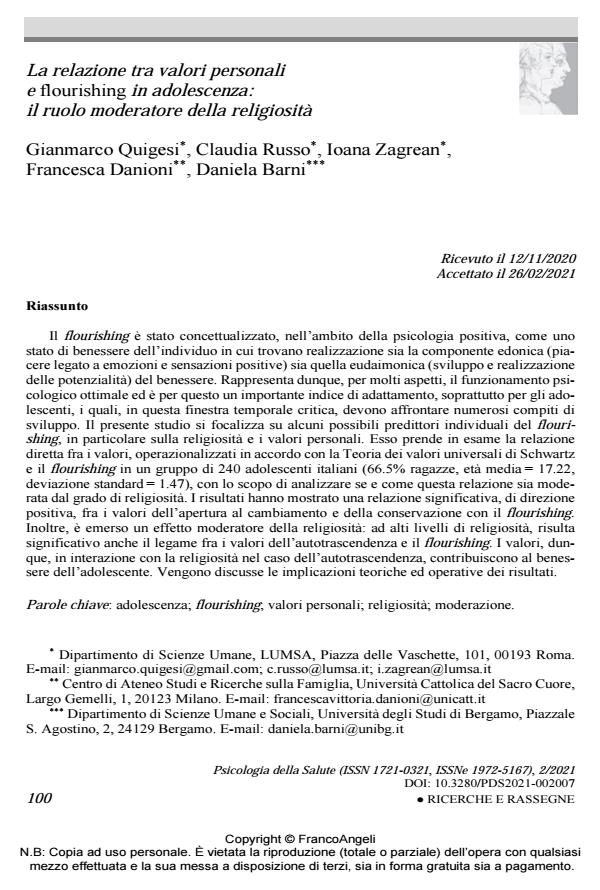The relation between personal values and flourishing in adolescence: The moderating role of religiosity
Journal title PSICOLOGIA DELLA SALUTE
Author/s Gianmarco Quigesi, Claudia Russo, Ioana Zagrean, Francesca Danioni, Daniela Barni
Publishing Year 2021 Issue 2021/2
Language Italian Pages 17 P. 100-116 File size 323 KB
DOI 10.3280/PDS2021-002007
DOI is like a bar code for intellectual property: to have more infomation
click here
Below, you can see the article first page
If you want to buy this article in PDF format, you can do it, following the instructions to buy download credits

FrancoAngeli is member of Publishers International Linking Association, Inc (PILA), a not-for-profit association which run the CrossRef service enabling links to and from online scholarly content.
According to positive psychology, flourishing is a state of well-being in which both the hedonic (pleasure related to both positive emotions and sensations) and eudaimonic (develop-ment and realization of potentialities) components are considered. As such, it represents the optimal functioning individuals may achieve, and for this reason, it is an important adjustment index, especially for adolescents, who, during this critical life period, have to deal with many developmental tasks. This study focused on some possible individual predictors of flourish-ing, such as religiosity and personal values. It took into account the direct path between values, operationalized according to Schwartz’s Theory of Universal Values, and flourishing in a group of 240 Italian adolescents (66.5% girls, Mage = 17.22, DSage = 1.47), with the aim to analyze whether and how this relationship is moderated by the level of religiosity. The results showed a significant and positive relationship between the values of openness to change and conservation with flourishing. Moreover, results pointed out a moderating effect of religiosity: at high levels of religiosity, the link between self-transcendence and flourishing is also signifi-cant. Thus, values, in general, and self-transcendence in the case of interaction with religiosity, contribute to adolescents’ well-being. The theoretical and practical implications of the results are discussed.
Keywords: Adolescence; flourishing; personal values; religiosity; moderation.
Gianmarco Quigesi, Claudia Russo, Ioana Zagrean, Francesca Danioni, Daniela Barni, La relazione tra valori personali e flourishing in adolescenza: il ruolo moderatore della religiosità in "PSICOLOGIA DELLA SALUTE" 2/2021, pp 100-116, DOI: 10.3280/PDS2021-002007